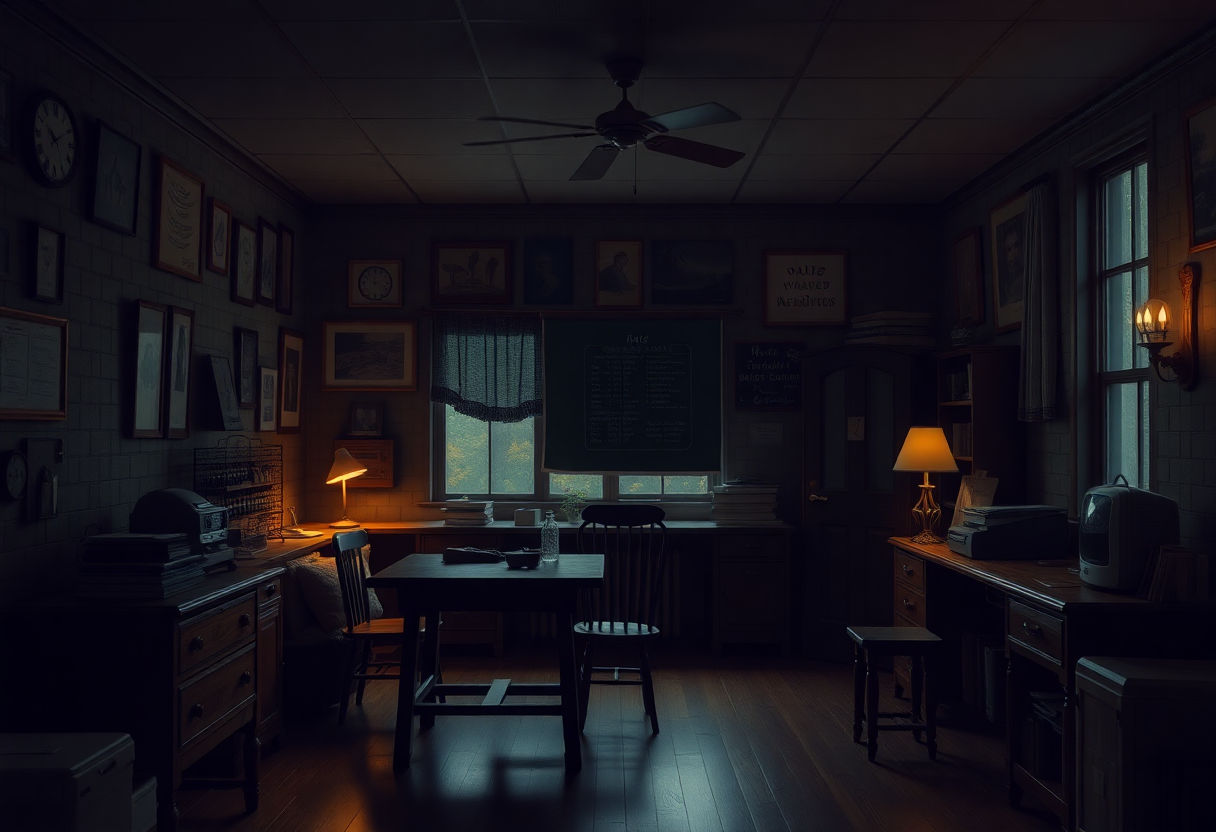The dark academia aesthetic captivates with its blend of classic literature, academia, and vintage allure, appealing to those who cherish intellectual and artistic pursuits. This article uncovers how to transform your space into a dark academia haven by exploring its historical roots, selecting a sophisticated color palette, and integrating vintage furniture alongside essential decor elements. Delve into lighting techniques that craft a moody ambiance, and learn to incorporate natural elements to enhance the space. With focused guidance on organization and art selection, create a room that embodies mystery and timeless elegance, inspiring creativity and contemplation.
Key Takeaways
- Achieving a dark academia aesthetic requires a focus on deep, rich color palettes that exude warmth and sophistication.
- Vintage furniture pieces are essential for adding elegance and scholarly charm to the space.
- Key decor items such as books, candles, and art create an intellectual and cozy atmosphere.
- Proper lighting is crucial to establish a moody yet inviting environment, using both lamps and natural light.
- Incorporating natural elements like plants and wooden accents enhances the aesthetic’s connection to timeless beauty.
Understanding Dark Academia

Dark academia is an aesthetic and lifestyle movement that draws its inspiration from the romanticized aspects of classical education and the literary culture of the past. It elegantly intertwines elements of Gothic architecture, European art, and vintage academia to create a unique, visually captivating style. Rooted in a profound appreciation for literature, philosophy, and an idealized version of university life, this aesthetic appeals to those who cherish introspection and intellectual pursuits.
The origins of dark academia can be traced back to the early 19th century, with profound influences from the Romantic Era. This period celebrated individualism and emotional depth, which are essential components of the dark academia aesthetic. The imagery often evokes scenes reminiscent of grand, timeworn libraries, ivy-clad university campuses, and stone hallways filled with candles and books. Each element paints a picture of a world in which knowledge and mystery coalesce.
Classical education plays a pivotal role in shaping this aesthetic. The admiration for ancient civilizations, such as Greek and Roman culture, is evident in the style’s classical references and motifs. Romanticism, a movement characterized by its emphasis on emotion and nature, melds seamlessly with these academic undertones, offering a rich tapestry of nostalgia and contemplation.
In embracing dark academia, individuals often find solace in an era characterized by an earnest pursuit of wisdom and aesthetic beauty, creating spaces that echo an old-world charm. This timeless style not only captivates with its visual appeal but also stimulates the mind, making it a beloved choice for those who yearn for a connection to the past.
Choosing the Right Color Palette

To capture the enchanting allure of dark academia, selecting the right color palette is pivotal. This aesthetic thrives on a rich, muted color scheme that exudes warmth and sophistication, illustrating the depth of classic literature and the heritage of academic traditions.
Deep, Earthy Tones: Start with a base of deep, earthy hues. Colors like charcoal gray, forest green, and burgundy serve as perfect foundations. These tones evoke a sense of mystery and timelessness, ideal for encouraging introspection and intellectual pursuits.
Warm Neutrals: Balance the richness of these hues with warm neutrals—think creamy beige or soft taupe. These shades create a harmonious backdrop, enhancing the primary deep tones while adding a layer of comfort and warmth to your space.
Plum and Rust Accents: Introducing accents in plum, rust, or even mustard yellow can add depth and interest. These colors inject a subtle vibrancy within the subdued environment, striking a perfect balance between elegance and liveliness.
Incorporating Metallic Finishes: To elevate the aesthetic further, consider integrating metallic finishes like brass or antique gold. These can be effortlessly included through frame borders, light fixtures, or hardware, adding a touch of opulence without overpowering the room’s understated charm.
The intention is to craft an environment where colors not only define visual allure but also evoke emotion. As Oscar Wilde eloquently stated, “Mere color, unspoiled by meaning, and unallied with definite form, can speak to the soul in a thousand different ways.” Let your chosen palette be an eloquent chapter in your own dark academia narrative.
Incorporating Vintage Furniture
Exploring vintage furniture is an essential step in crafting the perfect dark academia room. These pieces encapsulate the elegance and scholarly allure that define this aesthetic. Begin by seeking out items such as mahogany bookshelves, ornate writing desks, and velvet armchairs that exude a sense of history and intellect.
When selecting vintage furniture, prioritize pieces with a timeless design. Look for items crafted from rich woods like walnut or cherry, as these materials provide both durability and a classic appearance. Additionally, materials like leather and tweed can complement the warm, muted color palette typical of dark academia spaces.
Arrange furniture to create a functional yet romantic environment. Position a large, imposing desk by a window to take advantage of natural light, which is essential for both study and atmosphere. A comfortable reading chair can be placed in a cozy corner accompanied by a small table for cups of tea, creating the perfect spot for reflective reading sessions.
Consider mixing and matching different eras and styles. A Victorian chaise lounge can pair beautifully with an Art Deco lamp, offering a unique and sophisticated contrast. Importantly, each piece should speak to a sense of nostalgia and intellectual pursuit, evoking the grandeur of university libraries and scholarly settings.
Incorporating vintage furniture with a story or patina not only adds beauty but also infuses the room with a sense of history. By carefully selecting and thoughtfully arranging these pieces, you can embody the very essence of dark academia living.
Decor Essentials for Dark Academia
To embody the dark academia aesthetic, the right decor is pivotal in transforming a space into a haven of intellectual and vintage charm. Books are undeniably central to this theme. Consider curated collections of leather-bound classics and worn paperbacks that speak to a love of learning and history. These can be artfully stacked on shelves or surfaces, or even featured as part of a gallery wall.
Introduce candles to evoke a warm and inviting atmosphere. Opt for elegant candlesticks or candelabras placed strategically around the room to enhance the play of shadows and light, creating a cozy, contemplative environment. Lantern-like holders or wax-dipped bottles can also serve as evocative complements to your space.
Art plays a crucial role in expressing a sophisticated ambiance. Pieces rooted in realism, romanticism, or classical studies serve as profound nods to the aesthetic’s intellectual underpinnings. Consider hung paintings or framed sculptures that mirror the rich narrative threads inherent in great literary works.
Incorporating textiles such as velvet or heavy wool throws in deep hues can add layers of texture and comfort to your room. These materials work harmoniously with vintage rugs, which infuse both warmth and character.
Finally, the strategic use of mirrors and antique frames can yield both form and function. Mirrors with ornate details serve not only as decor but as a means to reflect light, enhancing the room’s depth and complexity. The overall atmosphere should exude an air of timeless learning and tranquil introspection, rich with cultural and intellectual allure.
Lighting and Ambiance

In creating the perfect dark academia room aesthetic, lighting plays a crucial role in shaping the ambient mood. A well-considered lighting scheme can transform your room into an intellectual haven reminiscent of old libraries and scholarly chambers.
To achieve this ambiance, aim for a combination of soft, warm lighting and natural light. Begin by incorporating table lamps and floor lamps with antique finishes. Opt for lampshades in muted materials such as parchment or matte fabrics, which diffuse light softly, casting a cozy glow reminiscent of candlelit reading spaces.
Candles are an essential element, offering a touch of authenticity. Consider classic candlestick holders or lanterns that add elegance and historical charm. When using real candles, remember to take safety precautions, or alternatively, choose high-quality LED candles for a similar effect without the risk.
Natural light should not be overlooked. Embrace large windows by using heavy curtains in rich colors, like deep greens or burgundies, which can be drawn back during the day to flood the space with light, highlighting the intricate textures of vintage décor.
The strategic placement of mirrors can enhance the natural illumination by reflecting light into darker corners, creating a sense of depth and bringing balance to the room. To maintain the ambiance after sundown, add dimmer switches to control the intensity of electric lighting, ensuring a seamless transition from day to night.
Ultimately, the goal is to curate an environment that feels intimate and contemplative, inviting prolonged study and introspection while exuding warmth and mystery.
Incorporating Natural Elements

To infuse a sense of organic beauty and serenity into your dark academia-themed room, consider incorporating natural elements that will not only enhance the aesthetic but also promote well-being. Begin with plants, as they bring life and a touch of greenery that contrasts beautifully with the deep, rich tones typical of dark academia. Opt for varieties such as ferns, ivy, or philodendrons which thrive in low-light conditions, ideal for moody ambient settings.
In addition to flora, integrate wooden accents to add texture and warmth, complementing the intellectual and vintage vibe of the space. Antique wooden shelves laden with books and curios, or a rustic oak writing desk, can create focal points that exude scholarly charm. The timeless appeal of wood conveys the romantic aspect of this aesthetic while maintaining a sense of groundedness.
Stone and metal elements can add further depth. A marble bust, metallic bookends, or a stone planter can serve as sophisticated decor pieces, offering contrast and a testament to classic artistry. Embrace these materials in subtle ways, ensuring they harmonize with the overall ambiance of the room.
For a final touch, consider incorporating textural elements such as wool throws or linen curtains to soften the space. These materials provide comfort and a welcoming atmosphere, enhancing the intellectual oasis you aim to create. Through these thoughtful additions, your room will reflect a balanced fusion of nature and academia, true to the dark academia ethos.
Art and Cultural References
Incorporating art and cultural references into your dark academia room can significantly enhance its scholastic and mysterious allure. Begin with classical artwork; paintings and sculptures inspired by the Renaissance or Baroque periods create an intellectually stimulating environment. Consider including replicas of works by artists such as Caravaggio or Rembrandt, whose use of chiaroscuro aligns well with the deep, muted color palette typical of dark academia.
Equally enriching are literary references. Integrate framed pages or quotes from classic literature, like those of Shakespeare or Shelley, which not only add a textual element to your decor but also celebrate the aesthetic’s deep literary roots. This can transform your space into a shrine of literary nostalgia.
Furthermore, you can introduce cultural artifacts emblematic of various historical eras. These could be globes, vintage maps, or ancient manuscripts that reflect a timeless curiosity and wanderlust, resonating with the theme of exploring distant lands and esoteric knowledge. Including such items invites guests to ponder the worldviews from different epochs.
To bring balance, consider setting an area with a gallery wall composed of both art and photographs, perhaps in monochrome, to evoke a sense of timelessness and depth. Mix and match varying sizes and styles while keeping a cohesive color tone for a curated yet collected feel. This technique ties together the visual and thematic elements, bestowing your room with a sophisticated, scholarly aura that embodies dark academia.
Maintaining a Clutter-Free Space

Maintaining a clutter-free space is essential for achieving the dark academia aesthetic, which thrives on a balance between scholarliness and elegance. The emphasis is on structure and organization, ensuring that every piece in the room contributes to the overall ambiance without overwhelming the senses.
Start by evaluating the items that define your space. Curate with intention; keep only what is functional or inspiring. A bookshelf, for instance, should display a thoughtful selection of classic literature and intriguing artifacts rather than a chaotic assortment.
Implement storage solutions that align with the aesthetic. Choose vintage-style trunks or discreet wooden boxes to tuck away non-essential items. These pieces not only help maintain tidiness but also add to the room’s charm.
Create focal points to draw attention. A well-organized writing desk can be a haven of inspiration; ensure it remains clutter-free by using compartments and holders for stationery. This approach maintains a visually appealing workspace while reinforcing the theme of intellect and study.
For decorative displays, rotate items seasonally to keep the environment fresh and engaging. A curated selection of framed art or sculptures can be changed periodically, lending a dynamic quality to the aesthetic without adding clutter.
Lastly, regularly assess and declutter to sustain a sense of order. Set aside time each month to review your possessions and eliminate those that no longer serve the room’s purpose. Through this process, the dark academia room remains a stylish retreat, characterized by its sophisticated balance of chaos and order.
Conclusion
In crafting your perfect dark academia room aesthetic, combining rich color palettes, timeless vintage furniture, and evocative decor pieces can transform any space into a haven of intellect and charm. By thoughtfully integrating natural elements and cultural references, you can achieve a harmonious balance that reflects both personal tastes and the aesthetic’s deep-rooted inspirations. Moving forward, continue to experiment with bold yet subtle changes, allowing your room to evolve into a personalized reflection of the dark academia ethos. Embrace this opportunity to cultivate a space that is not only visually engaging but also deeply inspiring.
Frequently Asked Questions
How can I source authentic vintage furniture for my dark academia room?
Finding vintage furniture can be both rewarding and challenging. Start by exploring local antique stores, estate sales, and second-hand shops. Online marketplaces and auctions can also offer a vast array of options for unique pieces.
What colors are best suited for a dark academia aesthetic?
The dark academia aesthetic thrives on a color palette of deep, rich tones. Opt for shades like charcoal, forest green, navy, and burgundy to imbue your room with warmth and sophistication, balancing these with neutral colors such as ivory or taupe.
How do I ensure my room doesn’t feel too cluttered while incorporating the dark academia style?
Maintaining a clutter-free space involves strategic organization and thoughtful placement of decor items. Prioritize functionality while displaying key pieces that highlight scholarly charm, like books, candles, or art, to preserve the aesthetic without overwhelming the space.
What are some quick ways to achieve the right ambiance with lighting?
To create the moody ambiance essential to dark academia, integrate varied light sources. Use table lamps with warm-toned bulbs for a cozy glow, and maximize natural light by keeping windows unobstructed during the day.
How can I include cultural references in my decor without overdoing it?
Incorporating cultural elements is about subtlety and significance. Choose a few meaningful pieces such as classical artwork, sculptures, or literary-themed decor that reflect a scholarly atmosphere and seamlessly integrate them into your existing room design.



